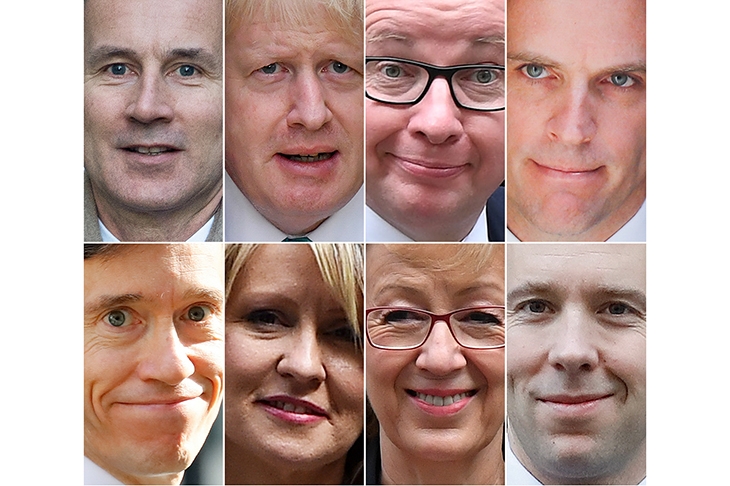The remarkable thing about the Tory leadership election is how long it has been coming. When Theresa May blew the party’s majority in the 2017 general election, few imagined that it would be two years before she quit as leader. What kept her in place was not a lack of Tory ruthlessness but a failure to agree on who should replace her.
A lack of consensus is the defining feature of this contest. No candidate is pulling ahead in the endorsements, and no one has the backing of most of the cabinet. Instead, the race is as fractured as it is crowded.
There are two sides to this election: full-on Brexit vs the cabinet. On the Brexit side, Boris Johnson is consolidating his position. He has the highest number of MPs backing him and is fighting this contest in propitious circumstances, as he is the Tories’ most obvious answer to Nigel Farage and the Brexit party. He has also shown a discipline that Westminster doesn’t normally associate with him. Rather than indulging in publicity stunts, he has kept working away on the MPs whose support he needs.
So far, Johnson has kept a low profile, eschewing media interviews. This has frustrated his rivals. They hope that two televised hustings will flush him out and create enough drama for the momentum to shift. But if he is 20 votes or more ahead of Dominic Raab in the opening round, he would be as certain as any candidate can be in such a crowded field of making it through to the final round. One of the cabinet candidates is even considering endorsing the former foreign secretary before he reaches the final two. Parties always overcorrect when picking a successor, and Boris the buccaneer is the opposite of May the vicar’s daughter. As one of the ministers backing him puts it: ‘We tried going for the safe choice and look what good that did us.’
On the cabinet side of the draw, the situation is more complicated. The order in which candidates are knocked out is going to be crucial. In the first round, Michael Gove needs to be in touching distance of Jeremy Hunt and far enough ahead of Matt Hancock that if Rory Stewart is knocked out, Stewart’s support will go straight to him rather than Hancock. Gove also faces a delicate balancing act of appealing to those worried about no deal while also maintaining the Brexiteer support that he still has. Further complicating the picture, Home Secretary Sajid Javid seems to be finally finding his mojo after a lacklustre start to the campaign.
Hunt’s problem is securing the parliamentary backing he needs to make the final two without further damaging his chances in the members’ round, if he even makes it that far. This explains his tortured position on whether no deal is suicidal or something that he’s prepared to countenance. Opinion in the Tory parliamentary party, as in the country, is polarising on the issue, which makes Hunt’s position particularly difficult.
I understand that the cabinet ministers most opposed to no deal have privately agreed to back either Hancock or Stewart in the first round. Some even argue that they should back Stewart because he is the candidate making a principled argument against leaving without a deal.
Everyone knows there is more than one round of voting. In the first round, many MPs will vote either to make a statement, or, in a surprisingly large number of cases, to help their friend. MPs don’t want to see their close colleagues publicly humiliated.
Even before the voting begins, two features stand out. First, there has been more Brexit realism than expected. Candidates aren’t proposing ripping up the whole withdrawal agreement. Instead, nearly everybody is talking about targeted changes to the backstop. Even Dominic Raab, widely regarded as the most hardline of the leading candidates, is only proposing a legally binding exchange of letters to give the UK an exit from the backstop.
If the new prime minister were to request a limited change to the backstop, that would be more challenging to the EU than a crude demand to rip up the whole deal. Despite Michel Barnier’s insistence that the only deal available is the one negotiated by Theresa May, some members of the EU would feel nervous about slamming the door in the new prime minister’s face. The EU won’t abandon the Irish or humiliate Leo Varadkar, of course. There might, however, be more chance of constructive dialogue than expected.
The timings will be difficult, though. The beating that the Tories took at the European elections for delaying Brexit has given 31 October, the new Brexit date, an almost religious status within the party. Boris Johnson is warning that another failure to leave on time could be an extinction event for the party. The problem, however, is that the new prime minister will take over at the end of July, and the next EU Council won’t be until 17 October. Even if a new prime minister succeeded in getting the EU to agree changes to the withdrawal agreement at this meeting, which would be impressively quick work, they would have only ten days to get the new deal through parliament and into UK law. This is not a realistic timetable.
The second feature is just how many candidates there are. It is easy to mock the number of people who are running, and it is a sign of how crowded the field is that special rules have been introduced to try to thin it out. But it is actually encouraging for the Tories for two reasons. First, competition drives up standards. Rory Stewart has, for example, made the other candidates better on social media. The second is that while the size of the field illustrates the fact that there is no perfect candidate, it also shows that there is talent in the Tory party. Theresa May has always been wary of ability. Even at the height of her powers she didn’t appreciate that cabinet ministers’ success was not threatening, rather it reflected well on her. Thankfully, the front runners in this Tory leadership race have a more generous attitude.
Whoever wins this contest will inherit a party in one of the worst states in its history. Nevertheless, the failings of Labour under Jeremy Corbyn mean that they may still have a chance of extending their stay in No. 10.







Comments